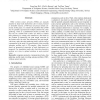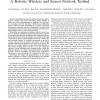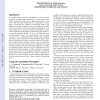92 search results - page 13 / 19 » Minimal energy path planning for wireless robots |
MDM
2009
Springer
14 years 1 months ago
2009
Springer
While wireless sensor networks (WSNs) are typically targeted at large-scale deployment, due to many practical or inevitable reasons, a WSN may not always remain connected. In this...
INFOCOM
2006
IEEE
14 years 22 days ago
2006
IEEE
Abstract— Simulation has been the dominant research methodology in wireless and sensor networking. When mobility is added, real-world experimentation is especially rare. However,...
IROS
2007
IEEE
14 years 1 months ago
2007
IEEE
—The F2 (Force Field) method is a novel approach for multi-robot motion planning and collision avoidance. The setting of parameters is however vital to its performance. This pape...
CORR
2008
Springer
13 years 6 months ago
2008
Springer
In wireless sensor networks, bandwidth is one of precious resources to multimedia applications. To get more bandwidth, multipath routing is one appropriate solution provided that ...
WIOPT
2005
IEEE
14 years 9 days ago
2005
IEEE
We consider the problem of transmission scheduling of data over a wireless fading channel with hard deadline constraints. Our system consists of N users, each with a fixed amount...



